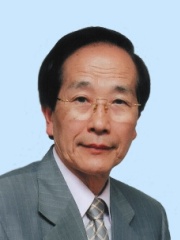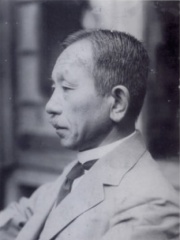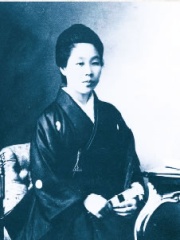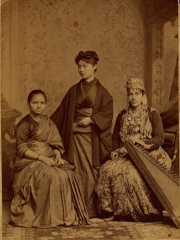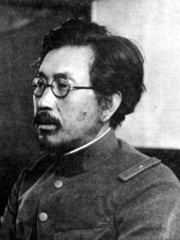
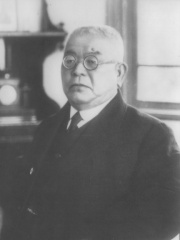
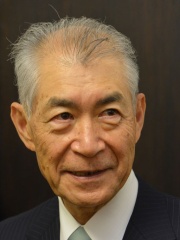
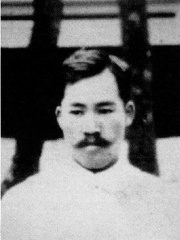
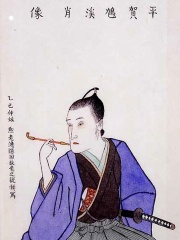
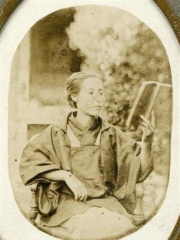
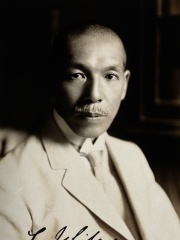
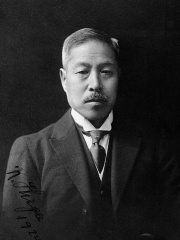
The Most Famous
PHYSICIANS from Japan
This page contains a list of the greatest Japanese Physicians. The pantheon dataset contains 726 Physicians, 14 of which were born in Japan. This makes Japan the birth place of the 10th most number of Physicians behind Turkey, and Switzerland.
Top 10
The following people are considered by Pantheon to be the top 10 most legendary Japanese Physicians of all time. This list of famous Japanese Physicians is sorted by HPI (Historical Popularity Index), a metric that aggregates information on a biography’s online popularity. Visit the rankings page to view the entire list of Japanese Physicians.

1. Shirō Ishii (1892 - 1959)
With an HPI of 66.59, Shirō Ishii is the most famous Japanese Physician. His biography has been translated into 33 different languages on wikipedia.
Surgeon General Shirō Ishii (Japanese: 石井 四郎, Hepburn: Ishii Shirō, [iɕiː ɕiɾoː]; June 25, 1892 – October 9, 1959) was a Japanese war criminal, microbiologist and army medical officer who was the director of Unit 731, a biological warfare unit of the Imperial Japanese Army. Ishii led the development and application of biological weapons at Unit 731 in Manchukuo during the Second Sino-Japanese War from 1937 to 1945, including the bubonic plague attacks at Chinese cities of Changde and Ningbo, and planned the Operation Cherry Blossoms at Night biological attack against the United States. Ishii and his colleagues also engaged in human experimentation, resulting in the deaths of over 10,000 subjects, most of them civilians or prisoners of war. In total, 300,000 people were killed by Japanese biological warfare. Ishii was later granted immunity in the International Military Tribunal for the Far East by the United States government in exchange for information and research for the U.S. biological warfare program.

2. Kitasato Shibasaburō (1853 - 1931)
With an HPI of 60.62, Kitasato Shibasaburō is the 2nd most famous Japanese Physician. His biography has been translated into 47 different languages.
Baron Kitasato Shibasaburō (北里 柴三郎, January 29 [O.S. 17 January] , 1853 – June 13, 1931) was a Japanese physician and bacteriologist. He is remembered as the co-discoverer of the infectious agent of bubonic plague in Hong Kong during an outbreak in 1894, almost simultaneously with Alexandre Yersin. Kitasato was nominated for the first annual Nobel Prize in Physiology or Medicine in 1901. Kitasato and Emil von Behring, working together in Berlin in 1890, announced the discovery of diphtheria antitoxin serum. Von Behring was awarded the 1901 Nobel Prize because of this work, but Kitasato was not.

3. Tasuku Honjo (b. 1942)
With an HPI of 58.41, Tasuku Honjo is the 3rd most famous Japanese Physician. His biography has been translated into 49 different languages.
Tasuku Honjo (本庶 佑, Honjo Tasuku, born January 27, 1942) is a Japanese physician-scientist and immunologist. He won the 2018 Nobel Prize in Physiology or Medicine and is best known for his identification of programmed cell death protein 1 (PD-1). He is also known for his molecular identification of cytokines: IL-4 and IL-5, as well as the discovery of activation-induced cytidine deaminase (AID) that is essential for class switch recombination and somatic hypermutation. He was elected as a foreign associate of the National Academy of Sciences of the United States (2001), as a member of German Academy of Natural Scientists Leopoldina (2003), and also as a member of the Japan Academy (2005). In 2018, he was awarded the Nobel Prize in Physiology or Medicine along with James P. Allison. He and Allison together had won the 2014 Tang Prize in Biopharmaceutical Science for the same achievement.

4. Hakaru Hashimoto (1881 - 1934)
With an HPI of 55.55, Hakaru Hashimoto is the 4th most famous Japanese Physician. His biography has been translated into 21 different languages.
Hakaru Hashimoto (橋本 策, Hashimoto Hakaru, May 5, 1881 – January 9, 1934) was a Japanese doctor and medical scientist of the Meiji and Taishō periods. He is best known for publishing the first description of the disease that was later named Hashimoto's thyroiditis.
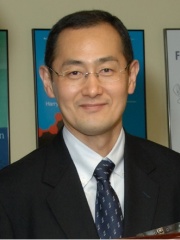
5. Shinya Yamanaka (b. 1962)
With an HPI of 54.41, Shinya Yamanaka is the 5th most famous Japanese Physician. His biography has been translated into 55 different languages.
Shinya Yamanaka (山中 伸弥, Yamanaka Shin'ya, born September 4, 1962) is a Japanese stem cell researcher and a Nobel Prize laureate. He is a professor and the director emeritus of Center for iPS Cell (induced Pluripotent Stem Cell) Research and Application, Kyoto University; as a senior investigator at the UCSF-affiliated Gladstone Institutes in San Francisco, California; and as a professor of anatomy at University of California, San Francisco (UCSF). Yamanaka is also a past president of the International Society for Stem Cell Research (ISSCR). He received the 2010 BBVA Foundation Frontiers of Knowledge Award in the biomedicine category, the 2011 Wolf Prize in Medicine with Rudolf Jaenisch, and the 2012 Millennium Technology Prize together with Linus Torvalds. In 2012, he and John Gurdon were awarded the Nobel Prize for Physiology or Medicine for the discovery that mature cells can be converted to stem cells. In 2013, he was awarded the $3 million Breakthrough Prize in Life Sciences for his work.

6. Hiraga Gennai (1728 - 1780)
With an HPI of 53.72, Hiraga Gennai is the 6th most famous Japanese Physician. His biography has been translated into 18 different languages.
Hiraga Gennai (平賀 源内, born c.1729; died 1779 or 1780) was a Japanese polymath and rōnin of the Edo period. He was a pharmacologist, student of Rangaku, physician, author, painter and inventor well known for his Erekiteru (electrostatic generator), Kandankei (thermometer): 462 and Kakanpu (asbestos cloth): 67 . Gennai composed several works of literature, including the fictional satires Fūryū Shidōken den (1763),: 486-512 the Nenashigusa (1763),: 463-486 : 115-124 and the Nenashigusa kohen (1768), and the satirical essays On Farting: 393–9 and A Lousy Journey of Love.: 62-4 He also authored two guidebooks on the male prostitutes of Japan, the Kiku no en (1764) and the San no asa (1768).: 75 His birth name was Shiraishi Kunitomo, but he later used numerous pen names, including Kyūkei (鳩渓), Fūrai Sanjin (風来山人) (his principal literary pen name), Tenjiku rōnin (天竺浪人) and Fukuchi Kigai (福内鬼外). He is best known by the name Hiraga Gennai.

7. Kusumoto Ine (1827 - 1903)
With an HPI of 52.63, Kusumoto Ine is the 7th most famous Japanese Physician. Her biography has been translated into 19 different languages.
Kusumoto Ine (楠本 イネ, 31 May 1827 – 27 August 1903; born Shiimoto Ine 失本 稲) was a Japanese physician. She was the first female doctor of Western medicine in Japan. She was the daughter of Kusumoto Taki, who was a courtesan from Nagasaki; and the German physician Philipp Franz von Siebold, who worked on Dejima, an island foreigners were restricted to during Japan's long period of seclusion from the world. Ine was also known as O-Ine and later in life took the name Itoku (伊篤). In Japanese she is often called Oranda O-Ine ("Dutch O-Ine") for her association with Dejima and its Dutch-language Western learning. Siebold was banished from Japan in 1829 but managed to provide for Ine and her mother and arranged for his students and associates to care for them. Ine's reputation grew after she became a doctor of Western medicine, and she won the patronage of the feudal lord Date Munenari. She studied in various parts of Japan under numerous teachers, one of whom impregnated her—likely having raped her—resulting in her only daughter; she never married. She settled in Tokyo after the country ended its seclusion, and assisted in the birth by one of Emperor Meiji's concubines in 1873. Since her death Ine has been the subject of novels, plays, comics, and musicals in Japan.

8. Shinobu Ishihara (1879 - 1963)
With an HPI of 52.50, Shinobu Ishihara is the 8th most famous Japanese Physician. His biography has been translated into 20 different languages.
Shinobu Ishihara (石原 忍, Ishihara Shinobu, September 25, 1879 – January 3, 1963) was a Japanese ophthalmologist who created the Ishihara color test to detect colour blindness. He was an army surgeon.

9. Kiyoshi Shiga (1871 - 1957)
With an HPI of 52.28, Kiyoshi Shiga is the 9th most famous Japanese Physician. His biography has been translated into 21 different languages.
Kiyoshi Shiga (志賀 潔, Shiga Kiyoshi, February 7, 1871 – January 25, 1957) was a Japanese physician and bacteriologist. He had a well-rounded education and career that led to many scientific discoveries. In 1897, Shiga was credited with the discovery and identification of the Shigella dysenteriae microorganism which causes dysentery, and the Shiga toxin which is produced by the bacteria. He conducted research on other diseases such as tuberculosis and trypanosomiasis, and made many advancements in bacteriology and immunology.
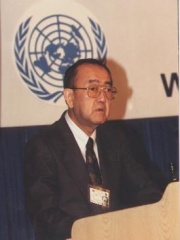
10. Hiroshi Nakajima (1928 - 2013)
With an HPI of 51.02, Hiroshi Nakajima is the 10th most famous Japanese Physician. His biography has been translated into 17 different languages.
Hiroshi Nakajima (中嶋 宏, Nakajima Hiroshi, May 16, 1928 – January 26, 2013) was a Japanese doctor known chiefly for his tenure as Director-General of the World Health Organization.
People
Pantheon has 15 people classified as Japanese physicians born between 1728 and 1962. Of these 15, 3 (20.00%) of them are still alive today. The most famous living Japanese physicians include Tasuku Honjo, Shinya Yamanaka, and Akira Endo. The most famous deceased Japanese physicians include Shirō Ishii, Kitasato Shibasaburō, and Hakaru Hashimoto. As of April 2024, 1 new Japanese physicians have been added to Pantheon including Kei Okami.
Living Japanese Physicians
Go to all RankingsTasuku Honjo
1942 - Present
HPI: 58.41
Shinya Yamanaka
1962 - Present
HPI: 54.41
Akira Endo
1933 - Present
HPI: 47.64
Deceased Japanese Physicians
Go to all RankingsShirō Ishii
1892 - 1959
HPI: 66.59
Kitasato Shibasaburō
1853 - 1931
HPI: 60.62
Hakaru Hashimoto
1881 - 1934
HPI: 55.55
Hiraga Gennai
1728 - 1780
HPI: 53.72
Kusumoto Ine
1827 - 1903
HPI: 52.63
Shinobu Ishihara
1879 - 1963
HPI: 52.50
Kiyoshi Shiga
1871 - 1957
HPI: 52.28
Hiroshi Nakajima
1928 - 2013
HPI: 51.02
Kyusaku Ogino
1882 - 1975
HPI: 50.60
Sunao Tawara
1873 - 1952
HPI: 49.82
Yoshioka Yayoi
1871 - 1959
HPI: 43.90
Kei Okami
1859 - 1941
HPI: 43.19
Newly Added Japanese Physicians (2024)
Go to all RankingsOverlapping Lives
Which Physicians were alive at the same time? This visualization shows the lifespans of the 9 most globally memorable Physicians since 1700.

